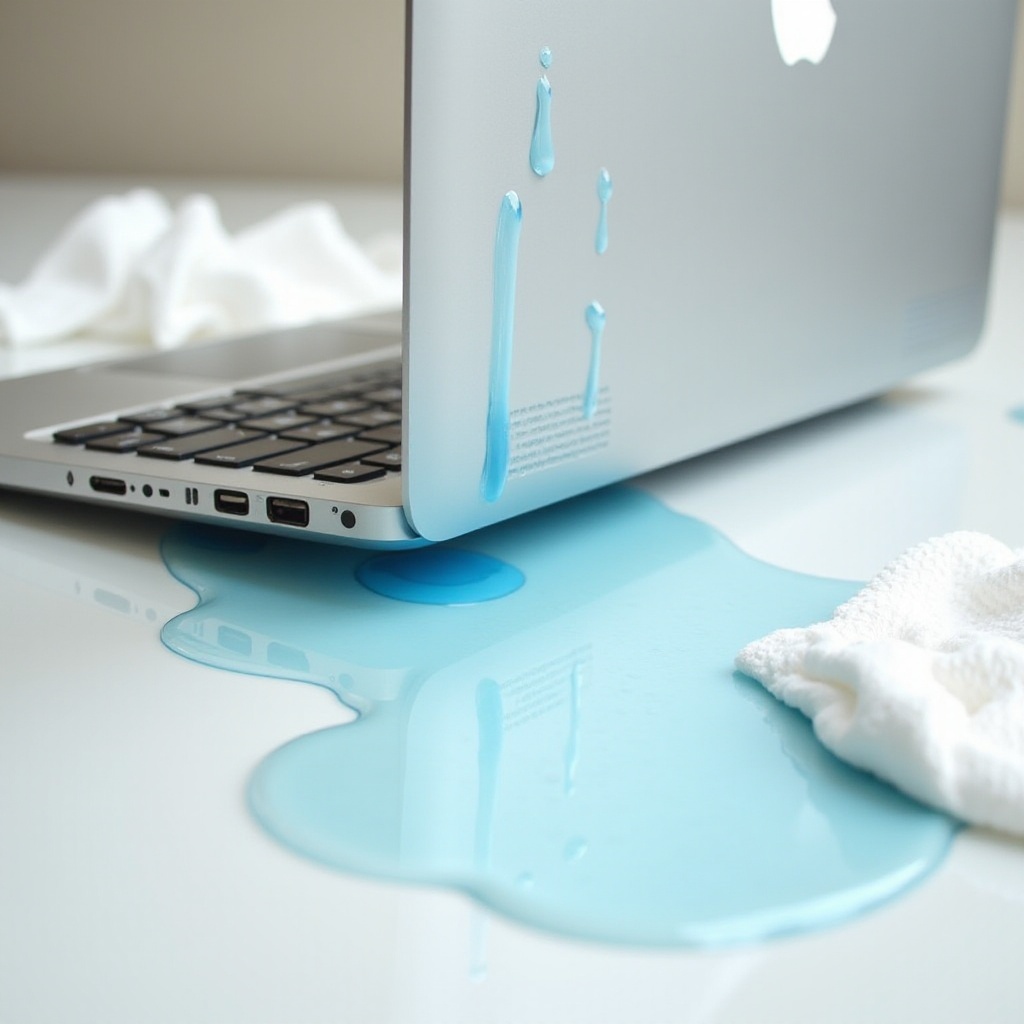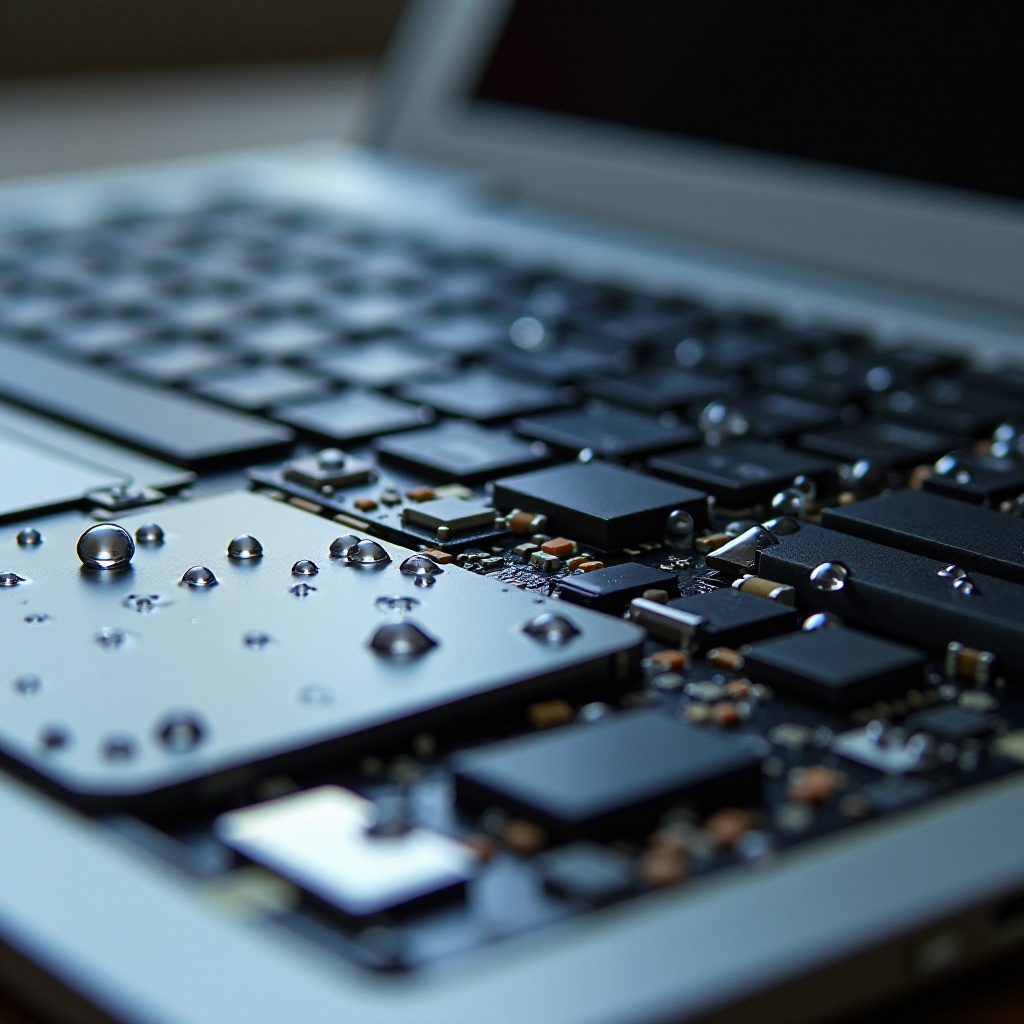Introduction
Discovering your MacBook has encountered water can be daunting, yet prompt action can often avert a complete malfunction. Whether it’s an accidental spill while working or an unexpected splash, knowing the appropriate first steps could significantly alter the outcome. This guide is designed to walk you through the essential processes of rescuing your MacBook from water damage in 2024. We will explore immediate responses, effective drying techniques, damage assessment, repair options, and preventive measures to sustain your device’s longevity.
The initial moments following water exposure are crucial. Let’s delve into the vital actions you need to undertake immediately after a spill.

Initial Response: What to Do Immediately After Spillage
Addressing water exposure swiftly is critical for mitigating potential damage to your MacBook. Here’s how you should respond:
-
Turn Off the MacBook: Quickly press and hold the power button to shut down the device. Avoid restarting to prevent short circuits.
-
Unplug and Disconnect: Safely remove the charger and any attached peripherals to minimize risk of further electrical damage.
-
Position Your MacBook: Arrange the MacBook in a tent position to assist in draining liquid from the keyboard area.
-
Remove Excess Water: Gently blot with a lint-free cloth or paper towel to soak up visible moisture.
-
Avoid Heat Sources: Steer clear of using hairdryers or heaters as they might force water deeper into the device.
With these preliminary actions completed, the drying process begins. This phase is crucial for reducing internal damage and preparing your MacBook for a thorough assessment.

Drying Process: Effective Techniques to Protect Your MacBook
Adopting correct drying methods is key in salvaging your water-damaged MacBook. Here’s how you can proceed:
-
Use a Fan: Position a fan to enhance airflow around your MacBook, aiding in the drying process.
-
Desiccants: Place silica gel packets near the MacBook to absorb moisture safely without risking heat damage.
-
Time and Patience: Allow ample time for your MacBook to dry, generally waiting at least 48 hours before powering it back on.
-
Periodic Checks: Regularly check drying progress, but resist the urge to turn the device on prematurely.
With drying underway, the next step is assessing the extent of the damage. This evaluation will aid in deciding between DIY repairs or seeking professional help.
Assessing the Damage: Identifying Affected Components
Understanding which parts might be affected is crucial when evaluating a water-damaged MacBook. Inspect the following areas:
-
Exterior: Look for signs of damage like corrosion around the keyboard and ports.
-
Battery: An enlarged or discolored battery often denotes severe damage and presents a safety hazard.
-
Internal Boards: If possible and safe, remove the back cover to check the logic board and other components for moisture or corrosion.
-
Display: Assess the screen for discrepancies or unusual behaviors once it’s safe to turn it back on.
Once you’ve pinpointed possible affected areas, deciding on professional repair services or DIY approaches becomes easier.

Professional Repair vs. DIY: Making an Informed Decision
Deciding between professional repair versus a DIY fix depends on assessing damage extent, costs, and your expertise level.
When to Opt for Professional Repair
-
Severe Damage: If numerous components exhibit damage, professional intervention is advisable.
-
Warranty Considerations: Check if you’re still within a warranty period, keeping in mind water damage is typically not covered.
-
Skill Limitations: Lack of technical knowledge often makes DIY attempts risky.
DIY Solutions and Common Pitfalls
-
Cleaning: Minor corrosion can sometimes be addressed at home with isopropyl alcohol on accessible areas.
-
Component Replacement: For tech-savvy individuals, replacing parts, such as the battery, may be feasible but exercise caution.
It’s crucial to recognize common pitfalls: DIY attempts can often exacerbate the problem or void any existing warranty. Major repairs should generally be left to professionals.
Evaluating Costs and Risks
-
Professional Services: Services vary in cost; getting quotes from trusted providers helps in decision-making.
-
DIY: Typically less expensive but heightened risk of causing further harm if errors occur.
Having weighed the repair options, focusing on preventive measures safeguards your MacBook against future water damage.
Preventative Measures to Avoid Future Water Damage
Securing your MacBook against potential water damage involves practical precautions:
-
Protective Covers: Invest in water-resistant keyboard covers and cases to shield your MacBook.
-
Designated Areas: Limit MacBook use near water, establishing a moisture-free workspace.
-
Regular Maintenance: Consistently clean ports and openings to avoid debris that could accrue moisture.
-
Consider Insurance: Look into electronic device insurance policies that encompass accidental water damage.
These preventive measures not only protect your MacBook but also extend its operational lifespan.
Conclusion
Taking immediate and appropriate actions can significantly influence a positive outcome when dealing with water-damaged MacBooks. Follow the outlined steps soon after exposure to bolster the chances of a full recovery. Whether you opt for professional repair or manage a DIY solution depends on damage severity and your technical acumen. Finally, employing preventive strategies contributes greatly in averting future water-related incidents, ensuring your investment stays protected.
Frequently Asked Questions
What should I do if my MacBook won’t turn on after getting wet?
If your MacBook doesn’t turn on after drying, it’s advisable to seek a professional evaluation to determine if repairs or replacements are required.
How long does it take for a MacBook to dry out completely?
Generally, it takes around 48-72 hours for a water-damaged MacBook to dry fully. Avoid rushing the process to prevent further damage.
Is water damage covered under the MacBook warranty?
Typically, water damage is not covered under Apple’s standard warranty. Review alternative insurance options that might cover such incidents.